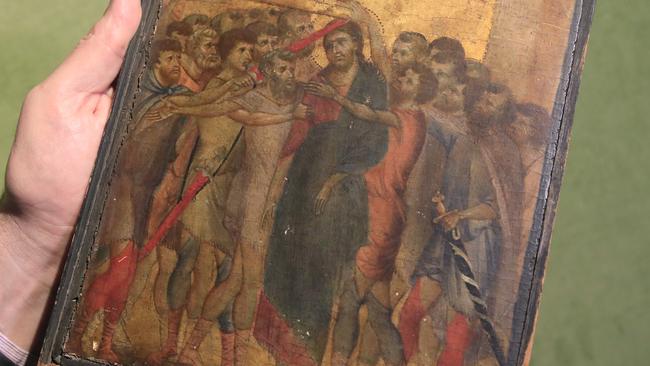Katy Hall: Cimabue painting in French kitchen is a compelling reason to hoard
In an age of minimalism and Marie Kondo, the temptation to toss everything from your house come moving day can be strong. But as one woman learned this week, some things are worth hanging onto, writes Katy Hall.

Rendezview
Don't miss out on the headlines from Rendezview. Followed categories will be added to My News.
When moving house, the temptation to throw everything you once cherished into a skip and call it a day can be overwhelming.
After all, who needs once-loved possessions masquerading as junk when you could be a minimalist with nothing but a single suitcase and a Marie Kondo ethos to your name? At the end of the day, it’s just stuff and there’s always more to be acquired at the swipe of a credit card, right?
The sensible thing to do, of course, is to take a middle ground and sell what you can before giving the rest to God. Such was the plan for one French family earlier this year when they were preparing their elderly mother’s home for sale and contacted a local auctioneer to flog what they could within a week before the rest would be tossed.
MORE FROM KATY HALL: Goodbye hygge, hello pantsdrunk
“I had a week to give an expert view on the house contents and empty it,” auctioneer Philomène Wolf told Le Parisien. “I had to make room in my schedule … If I didn’t, then everything was due to go to the dump.”

The family are surely thanking Wolf now, because in assessing the house a truly remarkable discovery was made. What had long believed to be nothing more than an unsuspecting religious painting hung above their mother’s kitchen hotplate for several decades was, it turns out, an original artwork by the 13th century Florentine painter Cimabue.
Considered to be the forefather of the Italian renaissance, the incredibly rare artwork titled Christ Mocked, sold for a cool $39 million at auction this week.
Who’s mocking whom now, eh?
RELATED: Early Renaissance painting found in French kitchen fetches $39 million
A similarly too good to be true discovery was made in 2013 when Father Jamie MacLeod took along a painting he’d purchased for $750 to a taping of the BBC’s Antiques Roadshow program in the UK and learned that what he thought may be worth a few thousand quid was actually an early work by baroque artist Sir Anthony van Dyck dating back to 1634.
Following an extensive restoration, the painting was given an estimate value of $940,000 and later sold privately. When asked what he’d like to do with the life-changing amount of money, MacLeod announced his plans to buy some new bells for his church.

And in the US in 2015, auctioneers called in to assess the value of a Los Angeles Lakers poster signed by Kobe Bryant were lucky enough to discover a previously unknown work by mid-century artist Jackson Pollock stashed in an elderly Arizona man’s garage. Despite heat, moisture and smoke damage, the work is estimated to be worth between $14 and $22 million.
MORE FROM KATY HALL: We don’t need Marie Kondo, we need self-control
It’s these kinds of stories of stumbling onto vast amounts of wealth unassumingly that makes eschewing the minimalist credo seem like a good idea. I’d be willing to live as a full-blown hoarder if it meant something within my possession would later sell for $39 million. Somehow, though, I just can’t imagine my used Tupperware fetching quite the same kind of prices in several hundred years time. Still, it’s surely a lesson before thinking twice before tossing things out.
As for the rest of the elderly woman’s worldly possessions, another 100 items went up for sale and brought in a further $9500 collectively, but the rest went to the local dump, where they’re surely be in good company with everyone else’s junk.
Originally published as Katy Hall: Cimabue painting in French kitchen is a compelling reason to hoard


